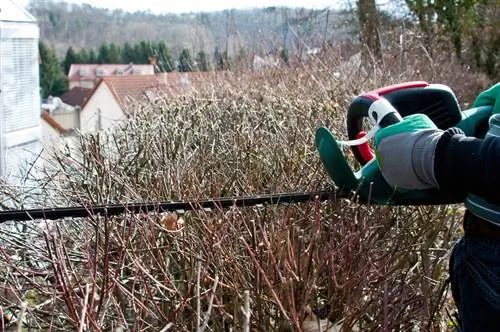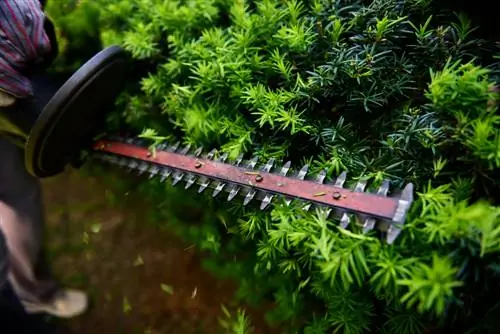- Author admin [email protected].
- Public 2023-12-16 16:46.
- Last modified 2025-01-23 11:20.
Forsythia hedges are not just planted in spring because of the many yellow flowers. They should also form a tight privacy screen in summer. With the right pruning you ensure that many leaves form after flowering.

When and how should you trim a forsythia hedge?
The best time to trim a forsythia hedge is in May or June after flowering. Prune to maintain shape, shorten long overhanging branches when pruning and remove dead and diseased branches when pruning. Every two to three years you should carry out a rejuvenation cut in winter.
What is important when cutting the forsythia hedge
For the hedge to fulfill its purpose, leaves and spring flowers must grow in a balanced ratio.
It is also important to ensure that the bush does not become too woody, because neither flowers nor leaves form on such shoots. These cuts are necessary to maintain the hedge:
- pruning
- Topiary
- care cut
- Rejuvenation cut
The best time for pruning
Forsythias tend to spread a lot. Regular pruning ensures that the shrub retains its shape.
It is best to prune in May or June after flowering. As soon as the flowers turn brownish, you can use hedge trimmers (€24.00 on Amazon). The forsythia then has enough time to form new shoots until the next flowering.
Cut out shoots that are too close together. You can also shorten heavily drooping branches.
Shape and care cut
A forsythia hedge cannot be kept under control like other hedges. Topiary pruning is possible at any time and is limited to shortening long protruding branches.
When pruning, you continually remove dead and diseased branches.
Rejuvenate forsythia in winter
So that the bushes do not become too bare, rejuvenation pruning is necessary every two to three years.
It is best done in winter or very early spring.
Cut all heavily woody shoots back to the ground.
Where should I put the forsythia pruning?
Younger forsythia branches in particular are easy to chop. You can use the chopped shrubs to spread mulch on beds or under trees.
Dog and cat owners should not leave the cut branches lying around. Forsythia is slightly poisonous and can cause discomfort in sensitive animals.
Tips & Tricks
Forsythias are not suitable as a permanent privacy screen. The spring bloomers are summer green and lose all their leaves in winter. Therefore, only plant forsythia as a hedge where you want to be protected from prying eyes during the summer.






